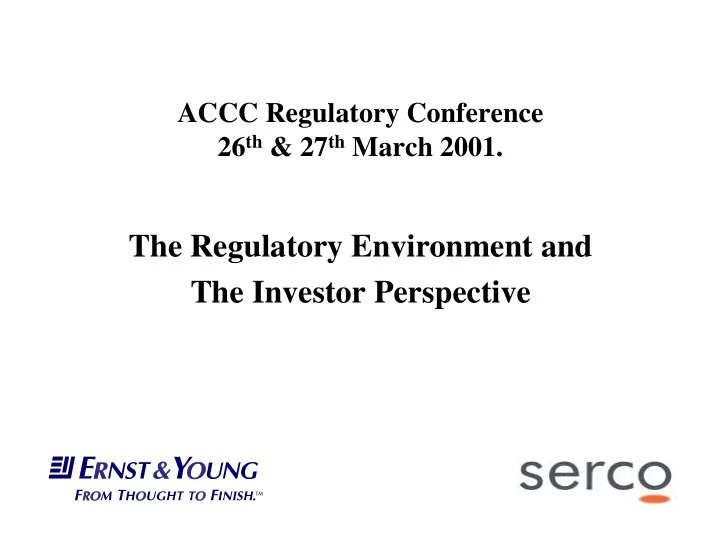

ACCC Regulatory Conference 26 th & 27 th March 2001. The Regulatory Environment and The Investor Perspective
The Regulated Utility • Predictability • Transparency • Efficiency
The Investment Decision The profile of … • Operational profitability • Capital expenditure • Taxation • Financial reserves • Reporting
Financial Assessments • The investment decision is based on the value of cashflows received. • Financing risks can be separated into Funding risk Interest rate risk
Benchmark Interest Rates • Nominal interest rates • Inflation indexed bonds • “Break-even” inflation
Benchmark Interest Rates Nominal yield = Break-even Inflation + Real yield observed in the market = Average Prospective Inflation + Historic inflation effect +Real yield observed = Average Prospective Inflation + Real yield Real yield = Real yield observed in the market + Historic inflation effect.
Benchmark Interest Rates • What happens if the market for Commonwealth Bonds becomes distorted? • Is there an increasing potential for utility debt to be issued to the wholesale market? • The potential for the formation of aggregated debt financing vehicles, with an investment profile which reflects the financial risk of the utility.
Benchmark Interest Rates Commonwealth CPI Bond Yields 6% 5% 4% 3% 2% 5 7 9 1 3 5 7 9 1 8 8 8 9 9 9 9 9 0 9 9 9 9 9 9 9 9 0 1 1 1 1 1 1 1 1 2
Revenue change potential % Revenue change, with 5yr WACC reset including inflation allowance, relative to year 1. 25% 20% 15% 10% WACC 5% 0% 1 6 11 16 -5% -10% -15% Year
Revenue change potential % Revenue change, WACC with annual interest rate adjustment including inflation allowance, relative to year 1. 25% 20% 15% 10% WACC 5% 0% 1 6 11 16 -5% -10% -15% Year
WACC determination ! The benefit of all stakeholders will be improved where the process of determining financial rates of return are: • Objective, taken from market benchmarks • Practical, in that the implicit funding should be marketable • Predictable, relative to current market benchmarks.
Movement in Real WACC • The regulation of utilities were initiated with the Real WACC, pre tax, 10.5% • Current Real WACC, pre tax, 7.0% ? • The total movement -3½ % - real interest rates -2½ % - model / parameters - 1% • These movements have altered the investment decisions and are driving changes to maintain equitable investment returns.
Compensating for the Changing Returns Reduce Operating Costs More Efficient Funding Options Change Risk Apportionment
Concept of Asset Owner and Operator Conventional Utility Operating Asset Co Op Co Contract Capex approval Audit of Assets 1. Infrastructure Investor 1. Operates the assets (Institutional) 2. Manages the business 2. Funds Capex 3. Guarantees return to 3. Approves Capex Program Owner Co 4. Audits Op Co’s 4. Seeks approval of Asset Performance on Asset Co to Capex Management 5. Competes for Contract
Who Bears the Risks? Asset Co: • WACC Risk • Stranded Assets OP Co: • Asset based risks eg breakdowns and supply outages • Level of operating and maintenance costs • Supply and operating agreements • Meeting KPI’s Potential Third Party: •Revenue risk - potential to hedge?
Considerations for Regulators Transparency • Separation of ownership costs and operating costs • Clear definition of Capex and Opex • Audit of operator’s asset management Efficiency • Contestability of operation reduces regulation • Lower cost due to funding and competition • Focus on asset management Predicability •Returns to stakeholders •Reduced risk
Rowville Transformer Features: • Asset Ownership is passive - TXU the operator • O&M is contracted for 29.5 years • No regulatory reset • Debt which is inflation linked • Revenue is inflation linked Risks • Operator has to ensure asset “is fit for purpose” • Asset owner takes force majeure and tax risk
UK Example - Purchase of Welsh Water by Glas Consortium Features: •Community purchasing the utility-non profit entity •Debt funded •Operations tendered in multiple contracts •Ofwat conditional approval Concerns of Regulator: •Minimal equity •Lack of shareholders - incentive for continued efficiency •Potential lack of control over contractors
The Regulated Utility • Predictability • Transparency • Efficiency
Recommend
More recommend